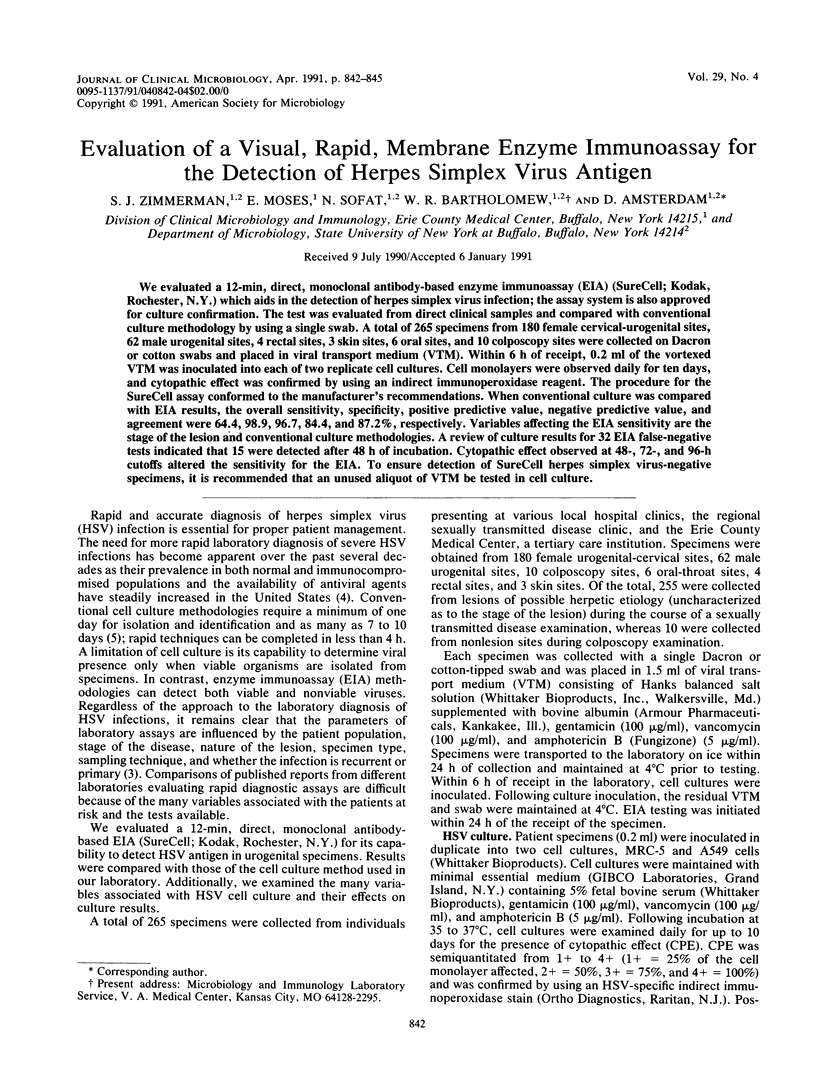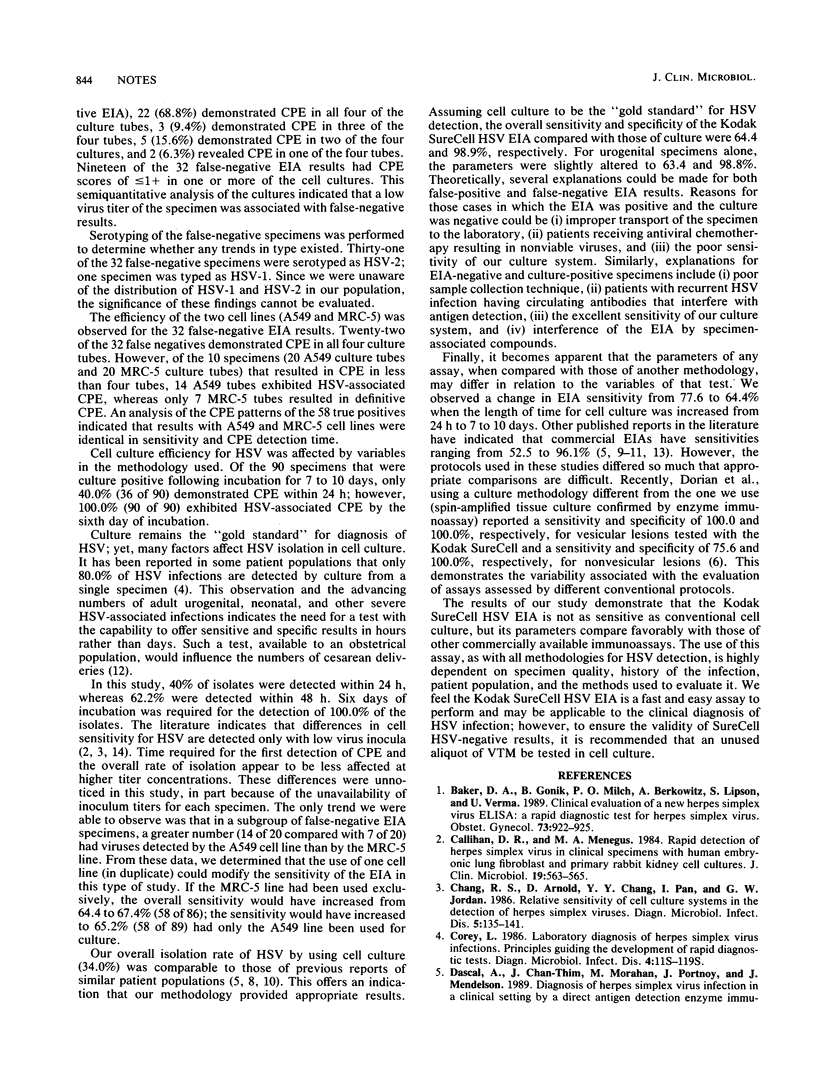Abstract
We evaluated a 12-min, direct, monoclonal antibody-based enzyme immunoassay (EIA) (SureCell; Kodak, Rochester, N.Y.) which aids in the detection of herpes simplex virus infection; the assay system is also approved for culture confirmation. The test was evaluated from direct clinical samples and compared with conventional culture methodology by using a single swab. A total of 265 specimens from 180 female cervical-urogenital sites, 62 male urogenital sites, 4 rectal sites, 3 skin sites, 6 oral sites, and 10 colposcopy sites were collected on Dacron or cotton swabs and placed in viral transport medium (VTM). Within 6 h of receipt, 0.2 ml of the vortexed VTM was inoculated into each of two replicate cell cultures. Cell monolayers were observed daily for ten days, and cytopathic effect was confirmed by using an indirect immunoperoxidase reagent. The procedure for the SureCell assay conformed to the manufacturer's recommendations. When conventional culture was compared with EIA results, the overall sensitivity, specificity, positive predictive value, negative predictive value, and agreement were 64.4, 98.9, 96.7, 84.4, and 87.2%, respectively. Variables affecting the EIA sensitivity are the stage of the lesion and conventional culture methodologies. A review of culture results for 32 EIA false-negative tests indicated that 15 were detected after 48 h of incubation. Cytopathic effect observed at 48-, 72-, and 96-h cutoffs altered the sensitivity for the EIA. To ensure detection of SureCell herpes simplex virus-negative specimens, it is recommended that an unused aliquot of VTM be tested in cell culture.
Full text
PDF



Selected References
These references are in PubMed. This may not be the complete list of references from this article.
- Callihan D. R., Menegus M. A. Rapid detection of herpes simplex virus in clinical specimens with human embryonic lung fibroblast and primary rabbit kidney cell cultures. J Clin Microbiol. 1984 Apr;19(4):563–565. doi: 10.1128/jcm.19.4.563-565.1984. [DOI] [PMC free article] [PubMed] [Google Scholar]
- Chang R. S., Arnold D., Chang Y. Y., Pan I. H., Jordan G. W. Relative sensitivity of cell culture systems in the detection of herpes simplex viruses. Diagn Microbiol Infect Dis. 1986 Jul;5(2):135–141. doi: 10.1016/0732-8893(86)90115-x. [DOI] [PubMed] [Google Scholar]
- Corey L. Laboratory diagnosis of herpes simplex virus infections. Principles guiding the development of rapid diagnostic tests. Diagn Microbiol Infect Dis. 1986 Mar;4(3 Suppl):111S–119S. doi: 10.1016/s0732-8893(86)80049-9. [DOI] [PubMed] [Google Scholar]
- Dascal A., Chan-Thim J., Morahan M., Portnoy J., Mendelson J. Diagnosis of herpes simplex virus infection in a clinical setting by a direct antigen detection enzyme immunoassay kit. J Clin Microbiol. 1989 Apr;27(4):700–704. doi: 10.1128/jcm.27.4.700-704.1989. [DOI] [PMC free article] [PubMed] [Google Scholar]
- Dorian K. J., Beatty E., Atterbury K. E. Detection of herpes simplex virus by the Kodak SureCell Herpes Test. J Clin Microbiol. 1990 Sep;28(9):2117–2119. doi: 10.1128/jcm.28.9.2117-2119.1990. [DOI] [PMC free article] [PubMed] [Google Scholar]
- Hursh D. A., Wendt S. F., Lee C. F., Gleaves C. A. Detection of herpes simplex virus by using A549 cells in centrifugation culture with a rapid membrane enzyme immunoassay. J Clin Microbiol. 1989 Jul;27(7):1695–1696. doi: 10.1128/jcm.27.7.1695-1696.1989. [DOI] [PMC free article] [PubMed] [Google Scholar]
- Land S. A., Skurrie I. J., Gilbert G. L. Rapid diagnosis of herpes simplex virus infections by enzyme-linked immunosorbent assay. J Clin Microbiol. 1984 Jun;19(6):865–869. doi: 10.1128/jcm.19.6.865-869.1984. [DOI] [PMC free article] [PubMed] [Google Scholar]
- Warford A. L., Chung J. W., Drill A. E., Steinberg E. Amplification techniques for detection of herpes simplex virus in neonatal and maternal genital specimens obtained at delivery. J Clin Microbiol. 1989 Jun;27(6):1324–1328. doi: 10.1128/jcm.27.6.1324-1328.1989. [DOI] [PMC free article] [PubMed] [Google Scholar]
- Warford A. L., Levy R. A., Rekrut K. A. Evaluation of a commercial enzyme-linked immunosorbent assay for detection of herpes simplex virus antigen. J Clin Microbiol. 1984 Sep;20(3):490–493. doi: 10.1128/jcm.20.3.490-493.1984. [DOI] [PMC free article] [PubMed] [Google Scholar]
- Warford A. L., Levy R. A., Rekrut K. A., Steinberg E. Herpes simplex virus testing of an obstetric population with an antigen enzyme-linked immunosorbent assay. Am J Obstet Gynecol. 1986 Jan;154(1):21–28. doi: 10.1016/0002-9378(86)90386-8. [DOI] [PubMed] [Google Scholar]
- Wu T. C., Zaza S., Callaway J. Evaluation of the Du Pont HERPCHEK herpes simplex virus antigen test with clinical specimens. J Clin Microbiol. 1989 Aug;27(8):1903–1905. doi: 10.1128/jcm.27.8.1903-1905.1989. [DOI] [PMC free article] [PubMed] [Google Scholar]
- Zhao L. S., Landry M. L., Balkovic E. S., Hsiung G. D. Impact of cell culture sensitivity and virus concentration on rapid detection of herpes simplex virus by cytopathic effects and immunoperoxidase staining. J Clin Microbiol. 1987 Aug;25(8):1401–1405. doi: 10.1128/jcm.25.8.1401-1405.1987. [DOI] [PMC free article] [PubMed] [Google Scholar]


